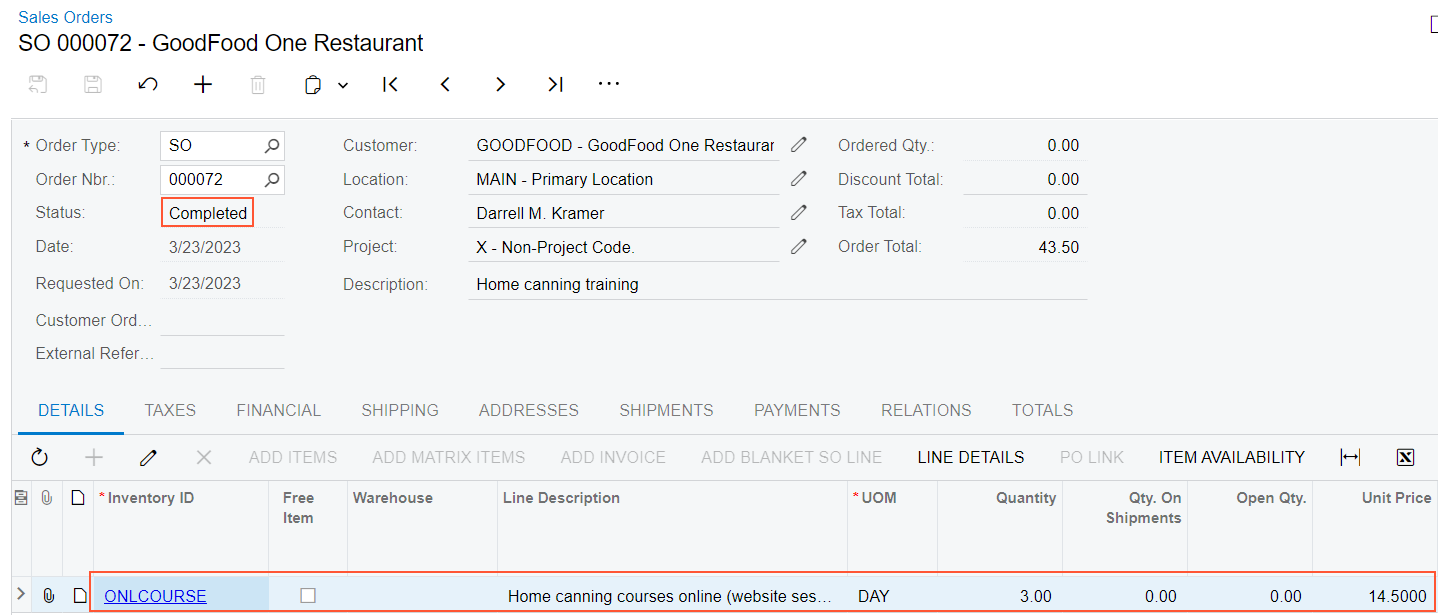Sales of Services: Process Activity
In this activity, you will prepare and process a sales order for non-stock items that represent services and thus do not need to be shipped to the customer's location.
Story
Suppose that the GoodFood One Restaurant manager has ordered a three-day training course on home canning for the restaurant's employees. The online course is a service, so no shipping needs to occur. You, as a sales manager, need to reflect these details in the system by entering and processing the appropriate documents.
Configuration Overview
In the U100 dataset, the following tasks have been performed to support this activity:
- On the Enable/Disable Features (CS100000) form, the Inventory and Order Management feature has been enabled.
- On the Order Types (SO201000) form, the SO order type has been configured and activated.
- On the Customers (AR303000) form, the GOODFOOD (GoodFood One Restaurant) customer has been created.
- On the Non-Stock Items (IN202000) form, the ONLCOURSE (Home canning courses online (website session) non-stock item has been created.
Process Overview
In this activity, you will create a sales order on the Sales Orders (SO301000) form, and then add a service line to it. After that, you will use the Invoices (SO303000) form to prepare a related invoice to the customer and release it.
System Preparation
Before you start processing a sales order that includes service items, you should do the following:
- Launch the MYOB Acumatica website with the U100 dataset preloaded, and sign in to the system as a sales and purchasing manager. You should sign in by using the norman username and the 123 password.
- In the info area, in the upper-right corner of the top pane of the MYOB Acumatica screen, make sure that the business date in your system is set to 1/30/2025. If a different date is displayed, click the Business Date menu button and select 1/30/2025 on the calendar. For simplicity, in this activity, you will create and process all documents in the system on this business date.
Step 1: Creating a Sales Order
To create a sales order, do the following:
- On the Sales Orders (SO301000) form, add a new record.
- In the Summary area, specify the following settings:
- Order Type: SO
- Customer: GOODFOOD
- Description: Home canning training
- On the Details tab, click Add Row on the table toolbar.
- Specify the following settings in the row:
- Inventory ID: ONLCOURSE
- Quantity: 3
- Unit Price: 14.5 (inserted automatically)
- On the form toolbar, click Save. Notice that the sales order has the Open status.
Step 2: Processing the Sales Invoice
To prepare and release the sales invoice that is related to the sales order, do the following:
- While you are still viewing the sales order on the Sales Orders (SO301000) form, on the More menu, click Prepare Invoice. The system prepares a sales invoice and opens it on the Invoices (SO303000) form.
- On this form, review the details of the prepared invoice. The invoice has one line on the Details tab, as the initial sales order does. In the Order Nbr. column of this tab, the system has inserted the reference number of the related sales order; this number is also a link you can click to view the document on the Sales Orders form. Notice that the Shipment Nbr. column of the Details tab does not have a reference number.
- On the form toolbar, click Release to release the invoice. The invoice is assigned the Open status. Once released, the invoice becomes visible on the Invoices and Memos (AR301000) form.
- On the Details tab, in the only row, click the link in the Order Nbr. column to view the associated sales order.
- On the Sales Orders form, which opens, review the details of
the sales order, as shown in the following screenshot. Notice that the sales
order has the Completed status, which the system assigned on release of
the sales invoice, and which means that the processing of the sale is
completed.
Figure 1. Completed sales order 
